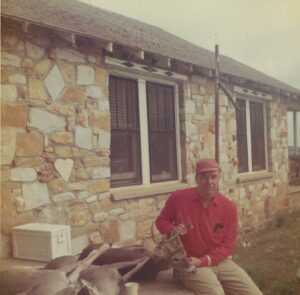by Bob Barnette

When I was a young boy in the 1960s, deer hunting was a big deal in my family. My dad, grandfather, uncles, my oldest brother, and a cousin or two all hunted together in the Texas Hill Country, typically in the Llano and San Saba areas. I was too young to join in with them yet. The older members of this group had started hunting in the late 1940s, as post-war recreational activities boomed in the U.S.
Deer hunting was very different then. “Deer Management” hadn’t been invented yet. Many areas of the Hill Country were severely overpopulated with deer, and landowners were just starting to catch on to the idea of leasing hunting rights on their ranches on either a season or day-lease basis to produce a bit of income. In the areas where my relatives hunted, there was a 2-buck limit, and doe harvest was actually controlled by the County Commissioners, who were authorized to issue “doe permits” to landowners. If your lease didn’t receive any of the blue note-card permits from the County, you didn’t get to shoot does. I don’t really know how the Commissioners allocated doe permits, but my perception was that it was based far more on let’s say “subjective factors” than any science-based process.
Choosing which bucks to shoot was quite easy – if it had antlers, it was shot at! There was no thought of passing on a deer to let it mature, or because it wasn’t big enough, or really any reason at all. Of course sometimes a large buck was encountered, but more often they were small ones that were likely only 1.5 or 2.5 years old. Thus the harvest of bucks was actually very similar to fishing – consider that when you are fishing, you have no control or influence over which fish takes your bait or lure. You get what you get. Deer hunting ended up the same way – you shot whatever buck you saw. And there were no feeders to attract or concentrate deer, so shot opportunities had to be taken quickly before the deer moved on.
When I was at home while the men were gone, I could only imagine what their hunts were like. It had to be awesome to go out on a ranch with a rifle and hope for a chance at a deer. It must have been adventurous, enduring cold weather in military-surplus wool pants and jackets (camo was not a Thing yet). My first brush with FOMO! There was little if any communication with them while they were gone, so whenever my dad returned home I’d run out to meet him with the question, “What did you get?” I couldn’t wait to learn the answer, and hopefully be able to see a set or two of skull-capped antlers. And Daddy was always proud to show off the results of his weekend. Size didn’t really matter, it was that he “got something.” And the stories of shots made and missed were always entertaining. I couldn’t take it all in fast enough. And I couldn’t wait until I was old enough to go.
Fast forward to modern times and think about what hunting is like now. We manage deer for quality (large) antlers, we strive to balance wildlife populations with the carrying capacity of habitats, and a huge industry has evolved around hunting, with more gear, tools, and gadgets available than could be dreamed of back in the 1960s. We can watch others hunt via all sorts of media, and a number of wild game chefs have helped us better understand how deliciously our harvests can be prepared. I’d be very curious to know how many thousands of corn feeders are in use in Texas to attract deer for hunting! In many areas hunting is less accessible now, also creating economic forces where those with means can buy or lease prime hunting opportunities.
I could never have foreseen that my journey as a hunter would include working on a professional basis for TWA to help young people learn about hunting and perpetuate the hunting heritage. My family members who pioneered hunting as part of our family lore are long gone. I wish I could visit with them and ask what their motivations were for deer hunting. I kinda doubt they had deep thoughts about hunting – it was probably a chance to get away “with the guys”, play some cards, and see if they had a chance to “get something.” Whatever their purposes, they considered it very worthwhile.
As hunting has evolved, it’s fair to think our motivations for hunting have changed too. The above-mentioned aspects still ring true, but I think many of us are much more reflective about our hunting. Why do we do what we do? We may consider aspects including conservation, land management, and obtaining high-quality, organic protein that we now have endless wonderful ways to cook. We might think about the impact of time spent outdoors on our relationships with folks we care about. We may ponder the time, energy and expense we devote to hunting, which like any activity can be done in a thrifty manner or a no-expense-spared approach. With so much competition for our time and resources now, being a hunter and making it happen require more than a casual effort. What is our Why? What is your Why?
Or you may simply ask yourself “What did you get?” A question worth examining after every outdoor experience, especially hunting! Hopefully the answer will reveal you received something of value from hunting, whether real or intangible, that will keep you going back again and again! At TYHP we are here to help you discover your Why about hunting, and help you answer the question of “What did you get?”!